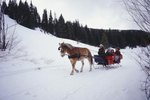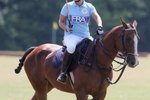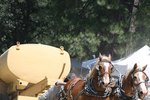
You can train any breed of horse to pull a carriage. However, for certain breeds, carriage driving is their primary purpose. Just as there are many makes of cars, there are various types of carriages. Horse can be driven singly, as a pair, or a foursome, known as a four-in-hand. Even larger hitches often feature draft horses, such as the famous Budweiser Clydesdales.
Draft Horses
If you're taking a carriage ride in New York City, Philadelphia or other large cities, more than likely you'll find a draft horse pulling the vehicle. Draft horses were bred to pull freight and can pull the equivalent of their body weight for short distances, such as the average commercial carriage ride. Draft horses weigh between 1,600 and 2,400 pounds, depending on the breed. Some of the common draft breeds used for carriage driving include the Percheron, Belgian, Clydesdale and Shire. Known as gentle giants, these huge horses also are bred for their good temperaments.
Show Horses
Horse shows around the country feature driving classes, many for individual breeds competing only against each other. The 2012 driving breed shows listed by Horse Show Central include the Hackney, Andalusian/Lusitano, American Saddlebred, Appaloosa, Arabian, Freisian, Morgan, Paso Fino, paint, pinto, Halfinger, Hanoverian, Holsteiner, Missouri Fox Trotter, Tennessee Walking horse, thoroughbred and quarter horse. Other driving events are overseen by the American Driving Society, which partners with various breed groups. As of 2013, the partnership includes the Andalusian/Lusitano, Connemara, Fjord, Freisian, Haflinger, Gypsy Vanner, Lippizan, Morgan, miniature horse, Shetland, Welsh pony, and the Standardbred through the U.S. Trotting Association.
Ex-Racehorses
Standardbreds race in harness, pulling lightweight sulkies. Once their racing careers are over, these horses can be retrained easily as pleasure driving animals. In the show ring, they can compete in roadster classes. These classes prove the Standardbred can do it all. In the roadster class, they are shown first under saddle, then harnessed to a race bike, similar to the sulky pulled in their racing days. In the final phase, they are hitched to a wagon, known as a doctor's buggy.
Ponies
You'll often find ponies pulling smaller carts. Shetlands and Welsh are favorites, although any pony can be used. For some ponies, this is a second career after the kids outgrow them for riding. Mom and Dad or the now-grown children still can have fun with their pony as a driving animal.
Combined Driving Events
Combined driving, sanctioned by the American Driving Society, consists of three phases: dressage, marathon and cones. According to the ADS, in dressage the horses or ponies and the driver "drive individually in specified patterns and gaits to demonstrate the skills, obedience, and development appropriate to their levels of training." In the marathon the following day, the competitors drive between 5 and 11 miles, depending on their level, negotiating obstacles, such as gates and driving through water. On the final day, during the cones competition, "Drivers and their steeds drive between precisely spaced pairs of cones over a prescribed course of up to 20 'obstacles' driven in correct sequence and direction," within an allotted time, according to the ADS. While any horse or pony may compete in combined driving, many of the European warmblood breeds are found at the high ends of the sport.
References
Resources
Photo Credits
-
Hemera Technologies/AbleStock.com/Getty Images
Writer Bio
Jane Meggitt has been a writer for more than 20 years. In addition to reporting for a major newspaper chain, she has been published in "Horse News," "Suburban Classic," "Hoof Beats," "Equine Journal" and other publications. She has a Bachelor of Arts in English from New York University and an Associate of Arts from the American Academy of Dramatics Arts, New York City.



